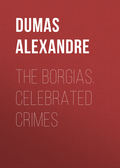
Александр Дюма
Cenci
Amidst the general feeling of relief afforded to the public by these favours, another tragical event changed the papal mind and frustrated all his humane intentions. This was the atrocious murder of the Marchese di Santa Croce, a man seventy years of age, by his son Paolo, who stabbed him with a dagger in fifteen or twenty places, because the father would not promise to make Paolo his sole heir. The murderer fled and escaped.
Clement VIII was horror-stricken at the increasing frequency of this crime of parricide: for the moment, however, he was unable to take action, having to go to Monte Cavallo to consecrate a cardinal titular bishop in the church of Santa Maria degli Angeli; but the day following, on Friday the 10th of September 1599, at eight o’clock in the morning, he summoned Monsignor Taverna, governor of Rome, and said to him —
“Monsignor, we place in your hands the Cenci case, that you may carry out the sentence as speedily as possible.”
On his return to his palace, after leaving His Holiness, the governor convened a meeting of all the criminal judges in the city, the result of the council being that all the Cenci were condemned to death.
The final sentence was immediately known; and as this unhappy family inspired a constantly increasing interest, many cardinals spent the whole of the night either on horseback or in their carriages, making interest that, at least so far as the women were concerned, they should be put to death privately and in the prison, and that a free pardon should be granted to Bernardo, a poor lad only fifteen years of age, who, guiltless of any participation in the crime, yet found himself involved in its consequences. The one who interested himself most in the case was Cardinal Sforza, who nevertheless failed to elicit a single gleam of hope, so obdurate was His Holiness. At length Farinacci, working on the papal conscience, succeeded, after long and urgent entreaties, and only at the last moment, that the life of Bernardo should be spared.
From Friday evening the members of the brotherhood of the Conforteria had gathered at the two prisons of Corte Savella and Tordinona. The preparations for the closing scene of the tragedy had occupied workmen on the bridge of Sant’ Angelo all night; and it was not till five o’clock in the morning that the registrar entered the cell of Lucrezia and Beatrice to read their sentences to them.
Both were sleeping, calm in the belief of a reprieve. The registrar woke them, and told them that, judged by man, they must now prepare to appear before God.
Beatrice was at first thunderstruck: she seemed paralysed and speechless; then she rose from bed, and staggering as if intoxicated, recovered her speech, uttering despairing cries. Lucrezia heard the tidings with more firmness, and proceeded to dress herself to go to the chapel, exhorting Beatrice to resignation; but she, raving, wrung her, hands and struck her head against the wall, shrieking, “To die! to die! Am I to die unprepared, on a scaffold! on a gibbet! My God! my God!” This fit led to a terrible paroxysm, after which the exhaustion of her body enabled her mind to recover its balance, and from that moment she became an angel of humility and an example of resignation.
Her first request was for a notary to make her will. This was immediately complied with, and on his arrival she dictated its provisions with much calmness and precision. Its last clause desired her interment in the church of San Pietro in Montorio, for which she always had a strong attachment, as it commanded a view of her father’s palace. She bequeathed five hundred crowns to the nuns of the order of the Stigmata, and ordered that her dowry; amounting to fifteen thousand crowns, should be distributed in marriage portions to fifty poor girls. She selected the foot of the high altar as the place where she wished to be buried, over which hung the beautiful picture of the Transfiguration, so often admired by her during her life.
Following her example, Lucrezia in her turn, disposed of her property: she desired to be buried in the church of San Giorgio di Velobre, and left thirty-two thousand crowns to charities, with other pious legacies. Having settled their earthly affairs, they joined in prayer, reciting psalms, litanies, and prayers far the dying.
At eight o’clock they confessed, heard mass, and received the sacraments; after which Beatrice, observing to her stepmother that the rich dresses they wore were out of place on a scaffold, ordered two to be made in nun’s fashion – that is to say, gathered at the neck, with long wide sleeves. That for Lucrezia was made of black cotton stuff, Beatrice’s of taffetas. In addition she had a small black turban made to place on her head. These dresses, with cords for girdles, were brought them; they were placed on a chair, while the women continued to pray.
The time appointed being near at hand, they were informed that their last moment was approaching. Then Beatrice, who was still on her knees, rose with a tranquil and almost joyful countenance. “Mother,” said she, “the moment of our suffering is impending; I think we had better dress in these clothes, and help one another at our toilet for the last time.” They then put on the dresses provided, girt themselves with the cords; Beatrice placed her turban on her head, and they awaited the last summons.
In the meantime, Giacomo and Bernardo, whose sentences had been read to them, awaited also the moment of their death. About ten o’clock the members of the Confraternity of Mercy, a Florentine order, arrived at the prison of Tordinona, and halted on the threshold with the crucifix, awaiting the appearance of the unhappy youths. Here a serious accident had nearly happened. As many persons were at the prison windows to see the prisoners come out, someone accidentally threw down a large flower-pot full of earth, which fell into the street and narrowly missed one of the Confraternity who was amongst the torch-bearers just before the crucifix. It passed so close to the torch as to extinguish the flame in its descent.
At this moment the gates opened, and Giacomo appeared first on the threshold. He fell on his knees, adoring the holy crucifix with great devotion. He was completely covered with a large mourning cloak, under which his bare breast was prepared to be torn by the red-hot pincers of the executioner, which were lying ready in a chafing-dish fixed to the cart. Having ascended the vehicle, in which the executioner placed him so as more readily to perform this office, Bernardo came out, and was thus addressed on his appearance by the fiscal of Rome —
“Signor Bernardo Cenci, in the name of our blessed Redeemer, our Holy Father the Pope spares your life; with the sole condition that you accompany your relatives to the scaffold and to their death, and never forget to pray for those with whom you were condemned to die.”
At this unexpected intelligence, a loud murmur of joy spread among the crowd, and the members of the Confraternity immediately untied the small mask which covered the youth’s eyes; for, owing to his tender age, it had been thought proper to conceal the scaffold from his sight.
Then the executioner; having disposed of Giacomo, came down from the cart to take Bernardo; whose pardon being formally communicated to him, he took off his handcuffs, and placed him alongside his brother, covering him up with a magnificent cloak embroidered with gold, for the neck and shoulders of the poor lad had been already bared, as a preliminary to his decapitation. People were surprised to see such a rich cloak in the possession of the executioner, but were told that it was the one given by Beatrice to Marzio to pledge him to the murder of her father, which fell to the executioner as a perquisite after the execution of the assassin. The sight of the great assemblage of people produced such an effect upon the boy that he fainted.
The procession then proceeded to the prison of Corte Savella, marching to the sound of funeral chants. At its gates the sacred crucifix halted for the women to join: they soon appeared, fell on their knees, and worshipped the holy symbol as the others had done. The march to the scaffold was then resumed.
The two female prisoners followed the last row of penitents in single file, veiled to the waist, with the distinction that Lucrezia, as a widow, wore a black veil and high-heeled slippers of the same hue, with bows of ribbon, as was the fashion; whilst Beatrice, as a young unmarried girl, wore a silk flat cap to match her corsage, with a plush hood, which fell over her shoulders and covered her violet frock; white slippers with high heels, ornamented with gold rosettes and cherry-coloured fringe. The arms of both were untrammelled, except far a thin slack cord which left their hands free to carry a crucifix and a handkerchief.
During the night a lofty scaffold had been erected on the bridge of Sant’ Angelo, and the plank and block were placed thereon. Above the block was hung, from a large cross beam, a ponderous axe, which, guided by two grooves, fell with its whole weight at the touch of a spring.
In this formation the procession wended its way towards the bridge of Sant’ Angela. Lucrezia, the more broken down of the two, wept bitterly; but Beatrice was firm and unmoved. On arriving at the open space before the bridge, the women were led into a chapel, where they were shortly joined by Giacomo and Bernardo; they remained together for a few moments, when the brothers were led away to the scaffold, although one was to be executed last, and the other was pardoned. But when they had mounted the platform, Bernardo fainted a second time; and as the executioner was approaching to his assistance, some of the crowd, supposing that his object was to decapitate him, cried loudly, “He is pardoned!” The executioner reassured them by seating Bernardo near the block, Giacomo kneeling on the other side.
Then the executioner descended, entered the chapel, and reappeared leading Lucrezia, who was the first to suffer. At the foot of the scaffold he tied her hands behind her back, tore open the top of her corsage so as to uncover her shoulders, gave her the crucifix to kiss, and led her to the step ladder, which she ascended with great difficulty, on account of her extreme stoutness; then, on her reaching the platform, he removed the veil which covered her head. On this exposure of her features to the immense crowd, Lucrezia shuddered from head to foot; then, her eyes full of tears, she cried with a loud voice —
“O my God, have mercy upon me; and do you, brethren, pray for my soul!”
Having uttered these words, not knowing what was required of her, she turned to Alessandro, the chief executioner, and asked what she was to do; he told her to bestride the plank and lie prone upon it; which she did with great trouble and timidity; but as she was unable, on account of the fullness of her bust, to lay her neck upon the block, this had to be raised by placing a billet of wood underneath it; all this time the poor woman, suffering even more from shame than from fear, was kept in suspense; at length, when she was properly adjusted, the executioner touched the spring, the knife fell, and the decapitated head, falling on the platform of the scaffold, bounded two or three times in the air, to the general horror; the executioner then seized it, showed it to the multitude, and wrapping it in black taffetas, placed it with the body on a bier at the foot of the scaffold.
Whilst arrangements were being made for the decapitation of Beatrice, several stands, full of spectators, broke down; some people were killed by this accident, and still more lamed and injured.
The machine being now rearranged and washed, the executioner returned to the chapel to take charge of Beatrice, who, on seeing the sacred crucifix, said some prayers for her soul, and on her hands being tied, cried out, “God grant that you be binding this body unto corruption, and loosing this soul unto life eternal!” She then arose, proceeded to the platform, where she devoutly kissed the stigmata; then leaving her slippers at the foot of the scaffold, she nimbly ascended the ladder, and instructed beforehand, promptly lay down on the plank, without exposing her naked shoulders. But her precautions to shorten the bitterness of death were of no avail, for the pope, knowing her impetuous disposition, and fearing lest she might be led into the commission of some sin between absolution and death, had given orders that the moment Beatrice was extended on the scaffold a signal gun should be fired from the castle of Sant’ Angelo; which was done, to the great astonishment of everybody, including Beatrice herself, who, not expecting this explosion, raised herself almost upright; the pope meanwhile, who was praying at Monte Cavallo, gave her absolution ‘in articulo mortis’. About five minutes thus passed, during which the sufferer waited with her head replaced on the block; at length, when the executioner judged that the absolution had been given, he released the spring, and the axe fell.






